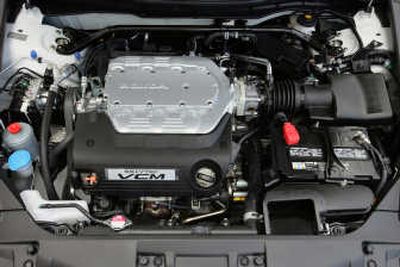Engine cylinder shut-off is newest gas-saving tool

ALEXANDRIA, Va. – With a daily round-trip commute of 120 miles, Marie Czapiewski needed good gas mileage in her new car but didn’t want to give up a V6 engine for something less powerful.
So when she bought another Honda Accord in September, Czapiewski was pleased to learn about a new feature that shuts off some cylinders in the engine when she’s cruising along Interstate 90 in southern Minnesota.
“With the V6, I’m getting 27 miles per gallon and that’s going at a high speed, too,” said Czapiewski, a 47-year-old customer service representative from Winona, Minn.
Cylinder deactivation systems have been available on some sport utility vehicles, pickup trucks and minivans for the last few years, and now the technology is becoming more widespread on passenger cars.
They can help people get more miles per gallon while keeping horsepower they crave. Honda Motor Co., General Motors Corp. and Chrysler LLC are bringing the systems to V8 and V6 engines.
“It’s adding that extra gas economy that everyone’s looking for right now,” said R.W. McKay, a general sales manager with Gordon Chevrolet in Tampa, Fla., who has the system on his 2007 Chevrolet Impala.
The technology helps the engine seamlessly operate on a reduced number of cylinders under light conditions, such as when a vehicle is on the highway. By shutting off cylinders, the engine reduces fuel consumption but still has the flexibility to provide more power when necessary.
Cylinder deactivation is part of a tool kit that the auto industry is using to improve fuel economy, said Mike Omotoso, senior manager of global powertrain for J.D. Power & Associates. The portfolio includes gas-electric hybrids, variable valve timing and “start-stop” technology that turns off the engine when the vehicle comes to a halt in traffic or at a stoplight.
“The consumer wants to have a powerful engine but hates to pay for the fuel that comes with the V8,” said Gottfried Schiller, director of engineering for engine management systems at auto supplier Robert Bosch LLC. He said the automakers “are looking for an effective way to give them both.”
Honda’s system, which is called Variable Cylinder Management, is available for the first time on the new Accord with automatic V6 engines. An earlier version of the system has been on the Odyssey minivan since the 2005 model year and the two-wheel drive Pilot SUV since the 2006 model year.
The Accord’s system allows the driver to operate on three, four or all six cylinders, depending on driving conditions. For example, a driver can stay in four-cylinder mode when driving along a highway with mild hills at speeds of up to about 80 miles per hour.
The driver, as a result, gets more power without compromising gas mileage.
For example, the 2008 Accord with an 3.5 liter V6 engine and a five-speed automatic transmission achieves 268 horsepower with fuel economy numbers of 19 mpg in the city and 29 mpg on the highway. That compares with an automatic, 2.4-liter inline four-cylinder engine on EX models that generates 190 horsepower with fuel economy marks of 21 mpg in the city and 31 mpg on the highway.
Czapiewski said the technology was ideal for her because southern Minnesota has its share of snow and icy roads during the winter and she wanted to have the power of a V6 engine. But she’s had to commute to Rochester, Minn., for the past four years as gas prices have risen.